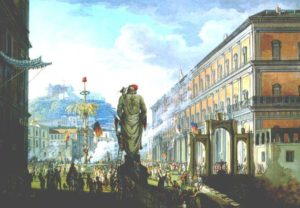 I have been working on a book on Nelson’s role in putting down the republic of Naples in 1799 for the last five years or so. I am glad to say that the resulting research will be published by Amberley as Nelson at Naples: Revolution and Retribution in 1799. It will be available in July. See the publications page here.
I have been working on a book on Nelson’s role in putting down the republic of Naples in 1799 for the last five years or so. I am glad to say that the resulting research will be published by Amberley as Nelson at Naples: Revolution and Retribution in 1799. It will be available in July. See the publications page here.
The revolution at Naples was a fascinating but rather bloody episode. Empires collapse, kingdoms fall but republics are not immune from bloody ruin. Such was the case in Naples in 1799. There the armies of the French republic had chased out the Bourbon royal family and established a liberal government of doctors, lawyers and intellectuals (some had been involved in a plot to overthrow the monarchy in 1794, read about that here). They lasted six months in office before a ferocious counter-revolution, led by a militant cleric, Cardinal Ruffo, swept them from power. Naples was the scene of the final agony of this transient republic, with the royalists exacting revenge in the streets or in the courts and on the scaffold. Hundreds died or were imprisoned or exiled, and the kingdom banished its intellectual elite and found its culture beheaded.
Set within that brutal history is a dramatic story of surrender and betrayal. In June 1799, as the republicans found themselves assailed by the forces of the reaction, many of them were hunted through the streets and put to death. A significant number, however, took shelter and were besieged within the forts of the capital. They capitulated to the cardinal on condition they would be safely transported to France, and the surrender was signed and sealed. Just then Horatio Nelson’s fleet arrived, and the British admiral rejected the treaty. Bolstered by the support of Sir William and Emma Hamilton, and with the vindictive Bourbons declaring that there would be no treating with rebels, Nelson violated the treaty of surrender. Through this controversial act, and after a tangled sequence of events, hundreds of Neapolitans, thinking themselves saved, now found themselves at the mercy of royalist revenge.
In Italy the event became synonymous with betrayal. But Nelson’s honour was also called to account in his native land. Charles James Fox railed against him in parliament in 1800. Nelson’s biographer, Southey, went as far as to state that the episode was “a deplorable transaction, a stain on the memory of Nelson and upon the honour of England”. G. K. Chesterton agreed, writing “Nelson turned his blindest eye On Naples and on liberty”.
My book on the revolution at Naples in 1799 which will look, in particular, at Nelson’s role in destroying the republic and the controversies surrounding his actions in the bay of Naples in June and July 1799. It also looks at life in Naples as it undergoes revolution in 1798 and 1799. The start of the book is presented here.
I’ve added some primary source material relating to Naples (life in the kingdom in the 1790s and the experience of revolution) Nelson (how he broke the treaty which protected the surrendered republicans, and how he hanged Admiral Caracciolo) and some letters from the summer of 1799:
From some of the captured republicans on the transports, detained by Nelson in contravention of the treaty of surrender.
A letter from Domenico Cirillo to Lord Nelson, asking that he be released from irons whilst he was confined onboard one of Nelson’s ships in the harbour of Naples in July 1799.
Excerpts from Camillo Elefante’s fascinating diary
What everyday life was like for Neapolitans (this one a middle class merchant) in 1799 as the royal family fled and the armies of the French revolution arrive.
Nelson’s order requiring Admiral Caracciolo to be taken to La Minerva frigate and hanged, then his corpse cut down and dropped into the sea. A rather vindictive execution of one of the leading Neapolitan republicans.
Sir William Hamilton’s first wife, and a letter describing the loss he felt when she died at Naples in 1782.
Sir William Hamilton’s second wife, Emma, and how she came to be in Naples.
Some letters by Giovanni Acton
A collection of letters from Giovanni Acton (Sir John Acton) to Sir William Hamilton. These deal with the evacuation of the Neapolitan royal family from Naples to Palermo in December 1798, an operation which involved loading the royal household and royal trasure onboard Nelson’s ships.
The Capitulation as seen by the French
The French commandant’s report to his superior detailing why the capitulation had been agreed, and confirming that the republicans would be spared and sent to Toulon.
The Capitulation of the Neapolitan Republicans
This is a draft of the actual treaty of surrender agreed and signed by Cardinal Ruffo and the republicans of Naples. The queen of Naples, Maria Carolina, got hold of the draft and wrote vindictive threats all over it. The original is in the British Library.
Two letters by Charles Lock (1799)
Young Charles Lock was a hostile witness when it came to Nelson. His two letters to General Graham, written in July and August 1799, summarise the case for the prosecution when it comes o Nelson’s actions at Naples.